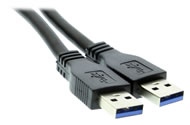USB 3.0 Cable Technology
 USB technology continues to expand as industries start to realize the benefits of USB 3.0 compared to its predecessor USB 2.0. USB 3.0 enables a 5Gbps data transfer speed in a cable, hub or other accessory and device designed with the super-speed specification in mind.
USB technology continues to expand as industries start to realize the benefits of USB 3.0 compared to its predecessor USB 2.0. USB 3.0 enables a 5Gbps data transfer speed in a cable, hub or other accessory and device designed with the super-speed specification in mind.
5Gbps is 10X the speed of USB 2.0 and opens the door to video applications, increased data speeds, and a new generation of devices that to support it. Because USB 3.0 technology is developing so fast, the specification has had to be renamed to Gen1 or generation 1 because generation 2 is right around the corner with 10Gbps data speeds through a simple cable connection. Generally a distinction that can be made between the 2.0 and 3.0 version is the port color, USB 3.0 is most commonly a blue color and USB 2.0 is white or black.
Introduction of Type-C
Although specifications of USB have changed, the cables purpose is still the same which is to transfer data at a specified speed and to be backward compatible with its previous version. The connectors for USB 3.0 have also changed somewhat with the introduction of type-C cable connections.
The USB 3.0 type-C port connector is a reversible USB connector much like the Apple Lightning and Thunderbolt cables, this connector doesn’t require an orientation making it much more user friendly while maintaining a high standard of performance. The type-C cable configuration can span the “USB connector” spectrum by using the opposite end of the cable as a host or device connector. A short list of USB type-C cable configurations is below:
- Type-C to Type-B
- Type-C to Type-A
- Type-C to Display Link
- Type-C to Type-C
- Type-C to Micro-B
USB cable length
Just like other cables, the type-C can be a long or short cable but stands by the USB specification length of 15 feet maximum in connection distance before signal breakdown occurs, this is one of the consistencies in an USB spec. To be clear, the type-C connector is also available in USB 2.0 specification format for compatibility with high-speed 480Mbps applications, as new computer systems are manufactured, the reversible connector is being incorporated into the design which makes it an in demand accessory.
